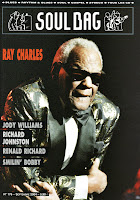Nothing much has been written about the publisher of Rock And Roll Roundup. All I know is his first name, Barry. He obviously had an ecclectic taste for contemporary music directed at 'teenagers', and he didn't discriminate between 'white' rock and roll and 'black' (rhythm and) blues. Although most articles seem to have been produced in coordination with record labels, it's clear that Barry liked decent copy and good photography.
The quality didn't really help to survive on the market. I've found only two editions, from February and April 1957.
The latter issue had an intriguing article about Adam Timon, whose name scores 0 (zero!!!) hits on Google, YouTube and Discogs, and a two page spread about Ray Charles.
Until 1960 Ray's story was hardly covered by the music press or the mainstream press. This rare article from February 1957 was clearly based on input by Atlantic Records. A few details are inconsistent with their usual PR talking points.
 |
| Publicity photo (mirrored) by James J. Kriegsman c. 1955. |
Fifteen years old, after leaving the school for the blind in St Augustine,
"[...] for two years [Ray] kicked around Florida with a variety of bands and combinations. [...] During this two-year period, Ray picked up a good deal of his knowledge of writing and arranging. [...] And somewhere along the line, he 'learned' to sing the blues. This singing came almost accidentally for Ray; he had to hum parts of his arrangements and ideas to express them to other musicians."
I've never seen writing charts and humming mentioned as the accidental origin of Ray's blues singing, and it doesn't seem very probable to me. It raises a good question, though:
when did Ray start singing in public as a professional?
"After two years of breaking in, as it were, Ray organized his own trio: bass and guitar to augment his piano and sax."
Up until today I have thought that Ray Charles started playing his alto saxophone in public when he started working with his small band, but I don't find it difficult to envision him also playing sax sometimes while working with the Maxin Trio, or - more incidentally - with the likes of Lowell Fulson, Big Joe Turner, or Joe Morris in the early 1950s. The repertoire of the Maxin Trio
must have been broader than just the songs we know from the 45" records - did it also entail danceable r&b, and jazz?




















